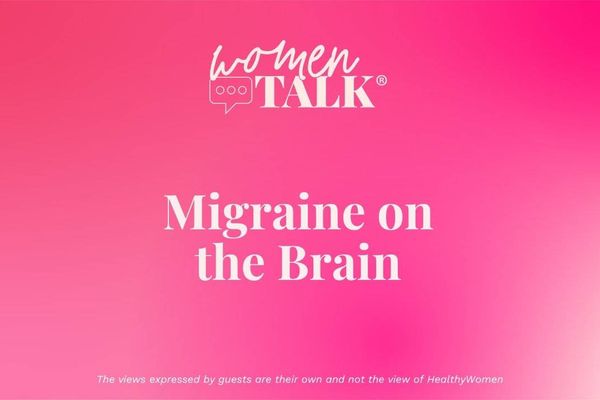Retired registered nurse Michelle Clapham was 11 or 12 when she started experiencing migraine attacks, about six months after she started getting her period. “I told my mom and she explained that many women in her side of the family had them,” Clapham said. “When I have a migraine, it feels like my head is in a vise, like someone is squeezing. It’s throbbing, and I sometimes get nausea with light sensitivity. At their worst point, I would stand in the middle of winter in my garage in bare feet on the cold concrete floor. That felt better than my headache. Anything to take my mind off of the pain.”
After experiencing one to three migraine attacks per month for decades, Clapham — now 63 years old — has fewer migraine attacks since she went through menopause.
Migraine is a disease that causes significant pain and affects your quality of life. It’s one of the most common neurological disorders in the world. About 39 million people live with migraine disease in the United States.
Although migraine disease affects both women and men, you are three to four times more likely to have migraine attacks if you’re a woman. Migraine attacks also last longer and have more severe symptoms in women.
Studies show that people who are in lower socioeconomic groups have more migraine attacks. And getting migraine care isn’t always easy if you’re Black or Hispanic. In fact, Black and Hispanic people are 25% and 50% less likely to be diagnosed with migraine disease, respectively, compared to white people.
Migraine triggers
There are many possible triggers for migraine attacks, and it can be hard to pinpoint what causes them. One common trigger for women is changes in their hormone levels, which is why some women find relief once they enter menopause. “It has a lot to do with hormones,” said Rashmi B. Halker Singh, M.D., a neurologist and member of HealthyWomen’s Women’s Health Advisory Council. “About a third of women will have migraine onset around the time of puberty. The common thing is that the migraines remain present throughout the childbearing years and that has a lot to do with the estrogen fluctuations.”
Other common migraine triggers include:
- Stress
- Bright lights
- Strong smells
- Too little or too much sleep
- Certain food or drinks
- Weather changes
Self-care for migraines
Not all migraine attacks are preventable, and there are medications that can help prevent or treat migraines once they occur. Self-care is also crucial when you recognize a trigger. Learning to avoid triggers in the first place is another important step for migraine self-care.
Avoid triggers. If your migraine attacks are caused by common triggers like lack of sleep, getting too hungry or being stressed, there are steps you can take that might reduce the number of attacks you experience. Maybe you can keep healthy snacks with you to ensure you always have something to eat if you need it. It may not be easy, but try to sleep on a regular schedule and identify methods to help manage stress, like practicing meditation or seeing a mental health professional.
Start early. If you get an aura (a warning that a migraine attack is on the way), try to start your self-care right away. If you don’t have any warning, start at the first sign of the migraine attack. Depending on what works for you, that could mean going into a dark room and resting, turning off any screens, applying hot or cold compresses to your head or neck, taking a warm shower, eating something, or hydrating yourself.
Eat a healthy diet. Eating a healthy diet reduces your risk of all kinds of diseases, and migraine is one of them. Following a healthy diet can also help minimize the number of migraine attacks you get or how bad they are when you get them. Avoiding known food triggers is important, too.
Exercise regularly. Getting regular exercise is always a good idea for your physical, mental and brain health. Exercise can reduce stress, which can help improve migraine attacks. But there’s another reason, too. There’s evidence that aerobic exercise can help reduce how often you have a migraine attack, how long it will last and how severe it will be.
Coping with migraine disease in the workplace
Regardless of how many migraine attacks you get, they can have an impact on your work life. If your migraine doesn’t go away with medication, Halker Singh suggests asking your healthcare provider if a preventive medication might help. There are many types of migraine preventive drugs, ranging from blood pressure-lowering drugs and antidepressants to Botox injections to migraine-specific medications. They might reduce the number of migraine attacks you get and may also lessen the symptoms for the ones that still occur.
If your migraine attacks are having an impact on your work, you could speak with co-workers, your boss or the company’s human resources department about things you can do to prevent them or what to do if one strikes while you’re there. Migraine disease can fall under the Americans with Disabilities Act, which means employers must make reasonable accommodations for their employees with migraine. Accommodations can range from initiating a no-scent policy for employees to providing restrooms that are dark and quiet, among others.
You don’t have to suffer
Halker Singh is excited about the future of migraine care. “We have had so many advances in our understanding of migraine and the treatment options we have available,” she said. “We have so many things that we can offer now. I think this is a time of hope. And more advances are coming.”
Until then, practice self-care to minimize the effects if you’re living with migraine disease.
This educational resource was created with support from Pfizer.
- All Migraines Are Not the Same ›
- Can Migraine Attacks Be Triggered? ›
- The Migraine Treatment You Don't—But Should—Know About ›
- Botox and Migraine: What You Need to Know ›
- Migraine Hub - HealthyWomen ›
- A Perfect Storm Migraine Attack Revealed the Limits of My “Push Through the Pain” Philosophy ›
- Migraine Headaches Are a Family Affair - HealthyWomen ›
- Got a Headache? Sometimes Less is More. - HealthyWomen ›
- Lo que debes hacer acerca de migrañas en el trabajo - HealthyWomen ›
- Foods That Can Make Your Headaches Worse - HealthyWomen ›
- 8 Types of Migraines - HealthyWomen ›
- 8 tipos de migrañas - HealthyWomen ›
- What To Do About Migraine at Work - HealthyWomen ›
- We Need to Raise Awareness of Migraines in the Workplace - HealthyWomen ›
- For Years, I Didn’t Know I Had Menstrual Migraines - HealthyWomen ›
- Pasé años sin saber que tenía migrañas menstruales - HealthyWomen ›
- Questions and Answers About Migraine Treatments - HealthyWomen ›
- The Relationship Between Migraine and Mental Health - HealthyWomen ›
- How to Support a Loved One with a Migraine - HealthyWomen ›
- La relación entre las migrañas y la salud mental - HealthyWomen ›
- Preguntas y respuestas relacionadas con los tratamientos de migrañas - HealthyWomen ›
- Cómo ayudar a un ser querido que tiene una migraña - HealthyWomen ›
- List of migraine resources - HealthyWomen ›
- WomenTalk: Migraine on the Brain - HealthyWomen ›






